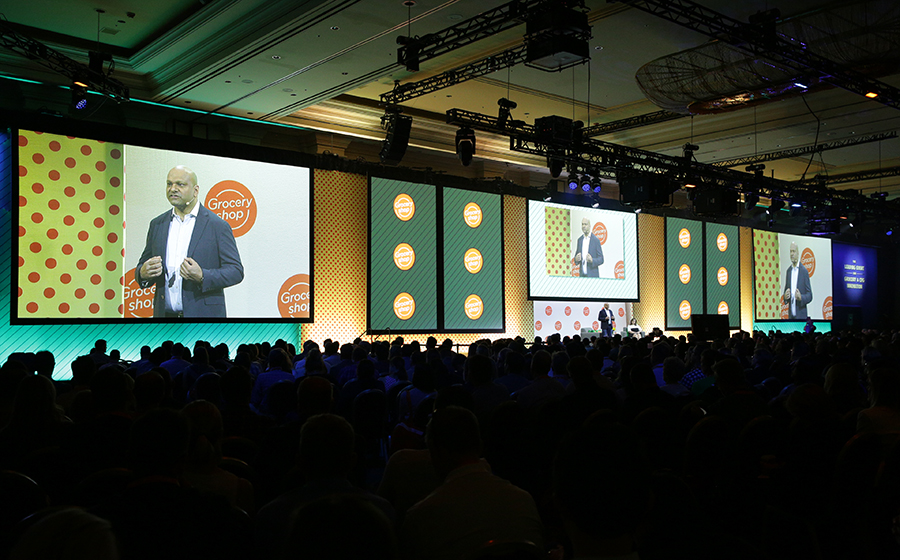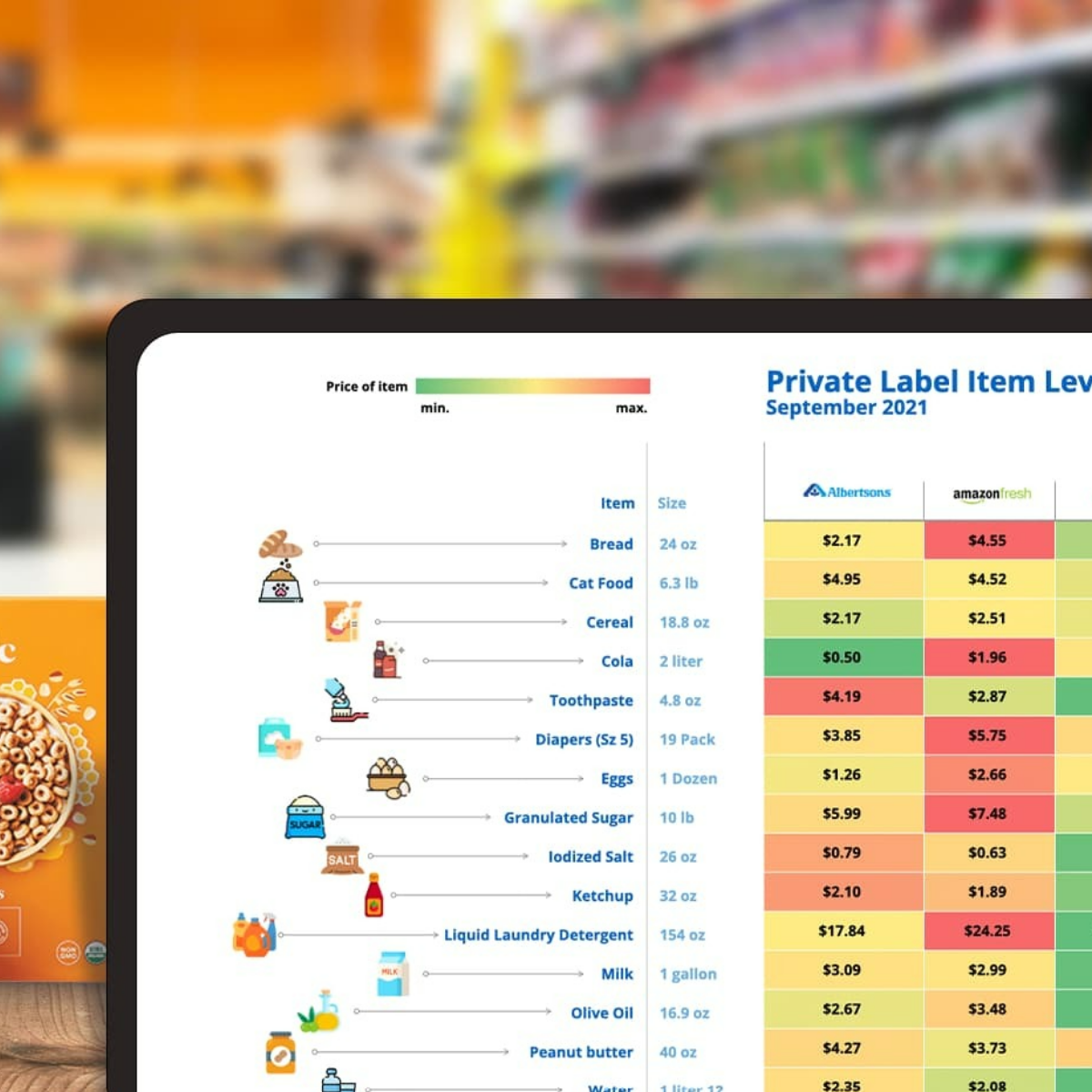Groceryshop 2019 took place in Las Vegas last week, bringing together the most curious of the curious in retail, CPG and tech for four days of keynote speeches, moderated panels, technology exhibitions, and pots and pots of convention grade coffee.
It did not disappoint.
\”Groceryshop is the best aggregation of players within the industry. It is a place where you can talk to anybody about anything,\” said Steven Reinemund, VP of eCommerce for The Hain Celestial Group.
The convention hall was frenetic, bustling with energy. One could walk the halls and serendipitously bump into John Furner, CEO of Sam\’s Club, on the right or see Carolyn Tastad, Procter & Gamble Group President, while standing in line at Starbucks on the left. There was almost too much to take in, which was a REALLY good thing.
The grocery industry is at a crossroads, so there should be too much to take in. Ever since Amazon purchased Whole Foods and then threw a further shot across the bow of the industry with Amazon Go, the entire industry has been scared straight. The pace of innovation in the last three to five years alone has probably eclipsed what occurred in the past 30 years, especially for an industry that has been stuck in neutral since the invention of the modern grocery store by Piggly Wiggly way back in 1916.
It\’s an attack coming from all sides — both overseas and across North America too. Nearly everyone is experimenting with something. As John Furner told me, the rubber will really meet the road, when retailers carve their own paths in seeking their answers from the \”innovation they see in the East, against the productivity (focus) of the West.\” These answers are still yet to be determined, but it is this intersection that will lead to salvation.
That is what Groceryshop is all about, a quest for the truth. It is not about the right answers, per se, but about having the conversations and the guts to run experiments that will all lead to a better place. Some of these eventual truths may be good, some may be bad, and most certainly some may even be quite ugly in the short- and long-runs but jumping into the crucible is what matters most.
So, here then, without further ado, are my good, bad, and ugly truths gleaned from four highly caffeinated days at Groceryshop 2019:
The Good: The Future Is Now
Groceryshop CEO, Anil Aggarwal, kicked off Groceryshop, as he always does, with pearls of wisdom that he later backed up with his actions.
\”Think in disruptive terms and then work backwards,\” he encouraged the audience during his opening keynote address on Sunday evening, and then he went out and did exactly that.
Aggarwal and team \”ate what they cooked\” (my quotes) by building a futuristic gigantic white dome that looked like it was straight out of a Mad Max movie, right smack in the middle of the trade show floor, that featured \”imagine if\” (also my quotes) 360-degree videos on the future of robotics in retail.
My love of Telly Savalas and Patrick Stewart notwithstanding, the Groceryshop thunderdome has to be one of the best domes of recent memory. The dome did exactly what Aggarwal preached in his speech — it showed what could be. It showed robots picking single items with suction-cupped hands in warehouses; robots fulfilling online orders within co-located automated fulfillment centers inside live Florida grocery stores; and robots wandering the stores to audit price tags and conduct inventory counts at a Walmart. All things that could seem far off in the future but, if one works backwards, are actually closer in the rearview mirror of grocery history than they appear.
In fact, Mad Max may have already left the building.
Schnucks VP David Steck and Giant Food Stores VP Sepideh Burkett, for example, got into a lively, spirited, and almost Miller Lite-like Taste Great/Less Filling debate on stage about the merits of their own, already-deployed shelf-scanning robots. And robotic micro-warehousing is already in pilot phases at many retailers too, like Albertsons, Stop & Shop, ShopRite, and Walmart.
The robots are not just coming. They are here already. The only remaining question is what happens next.
The Customer Stirs the Drink
Saying that the robots are coming is one thing but accepting it and knowing what to do about it is an entirely different story. Fortunately, the industry is singing a new refrain when it comes to innovation.
There was a noticeably different vernacular at Groceryshop 2019 vs. Groceryshop 2018 (or compared to any other trade show of recent memory). The tone shifted from one of dismissal (i.e. dismissal of Amazon, dismissal of new technologies, dismissal of VC-funded startups, etc.) to one of conscious enlightenment around one universal truth — the customer wants what technology can give to him or her, now.
\”The customer is leading the way,\” was the refrain first uttered Monday morning by Narayan Iyengar, Albertsons SVP Digital & eCommerce, in response to a question from grocery innovation guru James McCann, CEO of McCann Investments. This mantra was later reiterated by countless others on stage throughout the duration of the show.
Just as Furner hinted about the Chinese focus on innovation, last-mile delivery, checkout-free shopping, omnichannel personalization, etc. are all already present at scale overseas in China. How the smells and sounds of these innovations ultimately whet the appetites of the American consumer is still up for grabs. Finding the answers will come down to blending new retail experience designs for consumers against a backdrop of operational efficiency that makes things work financially.
Although no one yet knows what future solutions will look like or whom they will most impact, admitting that the industry is only on page one of the lesson plan in understanding the world that consumers DO want (rather than burying its head in the sand while the world changes) is a huge step in the right direction for the grocery industry.
The American consumer needs more and is demanding more from the industry when it comes to innovation. Shopping carts for kids that look like cars are no longer novel or imaginative enough to satisfy consumers.
The Bad: There\’s a New Sheriff in Town
While the customer has indeed spoken, driving innovation without laws or boundaries isn\’t good for anyone. The industry must know the rules of the road; sadly, the writers of these new rules are no longer who they once were (sorry, old white dudes).
Authority is starting to shift to a new sheriff in town — the digitally native brand and celebrity influencer, which means a hell of a lot of bad news for anyone still stuck in their old ways. Let alone who doesn\’t understand the power of influence in today\’s marketplace.
Incumbent, legacy brick-and-mortar retailers could be in for a world of hurt here if they are not careful. What was palpably obvious at the show via young entrepreneurs like Zak Normandin, Founder and CEO of Iris Nova, and Stu Landesberg, Co-Founder and CEO of the Grove Collective, was that they both know their customers at an individual level. They can design their products, their experiences, or their anything based on a deep one-to-one knowledge of everyone within their stable. That\’s a massive threat for legacy grocery brands.
Legacy players are lucky if they can bridge their online and offline data, let alone understand their customers outside of standard conventional marketing demographic cohorts (e.g., age, race, ethnicity, etc.).
In the past, this dichotomy didn\’t matter because e-commerce didn\’t exist. Going to stores was basically the only way to acquire product. As a result, store merchants became the authorities, the gatekeepers, and even the misguided and often hubristic emperors of what could or could not go inside the four walls of physical stores for decades.
Now, digitally native brands and celebrity influencers can have their own points of distribution via social media — and their own direct relationships with consumers. This paradigm shift shows just how little clothes these old-world emperors ever wore. As long as the new brand ambassador authorities have something that people want to hear, there are myriads of ways to get product to them. Stores are no longer as important of a part of the equation, nor is the garden variety skillset that so many legacy merchants mastered over their careers. Everyone needs a new toolbox.
Merchants once reigned supreme because consumers had no other choices. Now they do. As Aggarwal says, \”shopping is no longer synonymous with taking a trip to the store.\” The two concepts, once joined at the hip, no longer are, which means it is the now all-powerful consumer who decides in whom to place his or her trust.
The hard truth? Merchants no longer win by default.
Wasted Opportunities
One of the biggest disappointments of any trade show is when companies waste their opportunities on stage. Yes, I am calling it like it is here, Facebook and Coca-Cola. Two of the most well-known brands of all-time — one old world, one new world — both failed miserably in the airtime they had to fan the flames of industry education.
Facebook takes the top prize here. Eva Press, Facebook North America Group Lead, CPG, Healthcare & Retail, came to center stage greeted by what sound like a \”high school\” cheering section. In an oddly patronizing tone, she spoke about the ever-growing unimportance of Sunday circular advertising. The whole thing felt like we were in a major time warp. Newspaper ads, really? Was she still stuck in 2009? She was telling everyone in the room something we already knew. Facebook should be leading the wave on stage. Instead it self-servingly sold its advertising capabilities as today\’s circulars. An event devoted to big ideas and innovation is the wrong venue for that.
Same goes for Coke. I am sorry, but anytime someone gets up on stage (especially in light of everything described above) as Brian Sappington, the Chief Digital Integration Officer for Coca-Cola North America, did, and wastes stage time on the importance of something called a \”Digital Integration Council,\” I can\’t help but think such an initiative may be the canary in the coal mine of some tough years ahead.
So, here\’s a tip, Facebook, Coke, and others: Know your audience, know why they attend these shows in the first place and know how to keep your internal corporate agendas and self-promotion off a stage meant to be about industry enlightened education.
Ok. Rant over. Now onto the uplifting close.
The Ugly: The Last-Mile May Have Nothing to Do With Doorsteps
Truths, while ugly, can also be beautiful because problems offer the greatest opportunities. Last-mile delivery may offer a counterintuitive possibility.
While an explosion in direct-to-consumer grocery delivery is expected, the exact nature of how it will come about is still undetermined. Much has been made of the costs of last-mile delivery and many answers have been but forth to lower these costs, but nothing yet is crystal clear on how these issues will get solved or how product reliably goes the final 20 feet to the doorstep. There is still the issue of how to handle perishable produce, meats, frozen and refrigerated foods as well.
It is all ugly. But, ugly in the most beautiful, opportunistic way imaginable. What if, just what if, the answer has been staring us in the face this entire time? What if history is simply on the precipice of repeating itself, but with a slight twist?
The answers the industry seeks could, in fact, lie well outside the overwhelming industry focus on the last-mile doorstep delivery. Despite showing no signs of slowing down (nor should it, because doorstep delivery also makes people\’s lives better), there may be other important answers for grocery consumers out there.
What if equally profound answers are already visible within the early stage experimentation of an industry that itself was borne out of the consumer\’s desire to avoid the grocery store and home cooking altogether — the fast food industry, for example?
As I learned from Jaron Waldman, CEO of Rakuten Ready, during a podcast interview at the show, quick serve restaurants are oftentimes located in or around where people most need them physically and psychologically — e.g. on the way to and from home and work, near the gym, near a subway or train station, or adjacent to a gas station. He also explained that consumer interactions with quick serve restaurants and their operations are easily repeatable events, which lend themselves to automation. Said another way, technology is great at automating our habits — the same things we do over and over again.
When you put an automation/AI lens on things, it is easy to see why Starbucks has had the success it has seen with mobile payments and order pickup. And why McDonald\’s, Panera, and Chick-fil-A have all successfully been pioneers in adopting similar innovation. Just like grocery stores, McDonald\’s, Starbucks, etc. are also stores. But they are stores built around the idea of efficient, repeatable product acquisition, not shopping. They are, after all, platforms or, better yet, places of convenience.
The real question that defines the grocery store of the future is: To what degree do people want to shop vs. how much they just want to avoid the time and hassle it takes to get their products home? While shopping is important, particularly for grocery category that appeals to our five senses, new solutions for utilitarian convenience may be the long-term separator for the industry\’s successes and failures.
The final answers may lie in thinking about the word \”store\” itself as a reimagined place of product acquisition, rather than continuing to double down on making grocery more like e-commerce when no one, despite a hell of a lot of effort, has been able to do just that in the past 20 years. None of this makes anything discussed above either — robots, micro-fulfillment, etc. — any less important. It just changes the context for why they are important.
Groceryshop then, in its magic, helped to reframe some critical questions, like: What is a \”store?\” and why does a \”store\” have to be a place for shopping at all? Why can\’t buying groceries at a store be as easy as buying a morning cup of joe before work or a hamburger on a road trip, through the press of a few buttons, with almost zero marginal cost in terms of time?
Grocery \”stores\” can absolutely be recast like this. We just need to think about them not for shopping but as convenient points for product acquisition strewn about the American landscape in a new way. Last-mile delivery may indeed still explode via new high-tech solutions but confining the conversation and saying the doorstep is the be-all, end-all delivery destination also limits the potential of what these delivery innovations could breed.
The right next step is to think backwards, as Aggarwal suggests, with this new context in mind. Then and only then will the grocery industry uncover its full, untapped potential.



